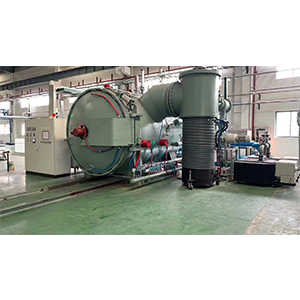Industrial heat treatment equipment - Vacuum furnace
Oct. 15, 2024
In modern industrial production, advancements in materials science have driven the development of numerous fields. Among these, vacuum furnaces serve as a crucial technical means, playing an indispensable role in metal processing, semiconductor manufacturing, aerospace, and other domains.
1. Overview
A vacuum furnace refers to an industrial equipment used for heat treatment in a high-vacuum environment. It achieves a preset vacuum level by evacuating the air inside the furnace, thereby enabling the heat treatment process of workpieces. Due to the high-vacuum conditions, adverse reactions such as oxidation and decarburization can be effectively reduced or even eliminated, thus enhancing the surface quality and internal properties of the workpieces.
2. Structural composition
1) Furnace Body: Made of high-temperature resistant materials, it ensures the internal temperature of the furnace while also being able to withstand certain pressure variations.
2) Heating Elements: Commonly used types include resistance wires and induction coils, which are used to provide heat.
3) Vacuum System: It includes vacuum pumps, valves, and measurement instruments, etc., used to establish and maintain the required vacuum environment.
4) Control System: It is responsible for monitoring parameters such as temperature and pressure, and adjusting the heating rate and vacuum level.
5) Cooling System: Crucial for applications requiring rapid cooling, it can be either gas or liquid cooling.
3. Working principle
When the pressure inside the furnace decreases to a certain level, the gaseous molecules on the material's surface diminish, making it less prone to chemical reactions (such as oxidation). Additionally, due to the absence of air convection, heat transfer primarily relies on radiation. This not only enables uniform heating of the workpiece but also allows precise control over the heating process, achieving high-quality heat treatment results.
4. Characteristics and advantages
Compared to traditional heat treatment methods, vacuum furnaces offer several significant advantages:
1) Prevention of Oxidation and Contamination: The high-vacuum environment virtually eliminates the impact of oxidation and other contaminants.
2) Enhanced Material Properties: It enables the attainment of a purer surface quality, improving the mechanical properties of the material.
3) High Degree of Controllability: By precisely controlling conditions such as temperature and pressure, more intricate operations can be achieved.
4) Energy-saving and High Efficiency: Compared to conventional furnaces, vacuum furnaces generally consume less energy and operate more efficiently.
5) Broad Application Range: From metal parts to semiconductor devices, suitable vacuum treatment methods can be found for a wide range of applications.
5. Specific applications
1) Metal Processing: Quenching, annealing, solid solution treatment, etc., for materials like titanium alloys and stainless steel.
2) Semiconductor Manufacturing: Used in processes such as crystal growth and thin-film deposition.
3) Aerospace: Precise heat treatment of aircraft components to enhance their corrosion resistance and strength.
4) Medical Equipment: Requires a sterile and contamination-free environment during the manufacturing process.
5) Scientific Research Experiments: Also applied in basic research in fields such as materials science and physical chemistry.










